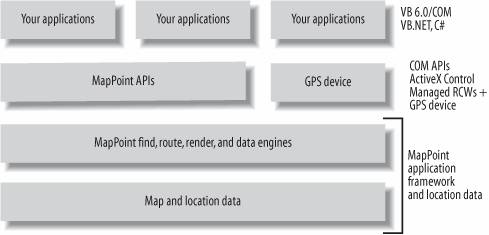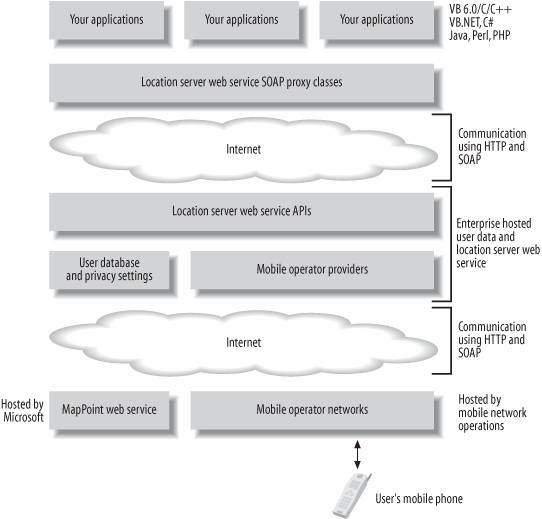Section 1.4. Developing Location-Aware Applications
1.4. Developing Location-Aware ApplicationsLocation-aware applications (or real-time location applications ) apply your current location when processing information to provide smart choices. The kinds of applications that fall into this category are:
To build this category of applications using MapPoint technologies, you have two choices (yes, again!): disconnected and connected applications . 1.4.1. Disconnected Applications Using MapPoint 2004 and GPSMapPoint 2004 provides necessary APIs and location data to build location-enabled applications; however, you can also build disconnected location-aware applications using MapPoint 2004 by interfacing a location-aware hardware such as Global Positioning Satellite (or simply GPS) devices. Even though MapPoint 2004 does not provide ready-to-use APIs for GPS interfacing, it is relatively easy to use real-time information from a GPS device in the MapPoint application environment. Figure 1-7 shows how your location-aware applications build on MapPoint 2004 and a GPS device. This architectural layer is not very different from Figure 1-3, except that this application uses a GPS device for real-time information.
The most common scenarios for this architecture include real-time navigation applications, real-time location based information logging applications. Figure 1-7. Location-aware application using MapPoint 2004 with a GPS device 1.4.2. Connected Applications Using MapPoint Location ServerMapPoint Location Server is an enterprise-hosted server that enables real-time location scenarios using a locatable device, such as a mobile phone or a pager. MapPoint Location Server does not require any location-related hardware, such as GPS devices; instead, it locates a provisioned (registered) user's mobile device by communicating with a mobile operator. In a typical scenario, a user requests his position using a mobile device equipped with a client that communicates with MapPoint Location Server. When MapPoint Location Server receives the request from the client, it identifies the mobile operator for the user and sends a location request to the mobile operator, which responds by sending back the real-time location of the user, expressed as latitude and longitude coordinates. MapPoint Location Server then requests a map or other location information from MapPoint Web Service to process the user's real-time location. All communications specific to a mobile operator are hidden from end users and developers. Thus, MapPoint Location Server works as an aggregator for mobile operators by abstracting implementation details that are specific to the mobile operator to obtain a real-time location. Once the location is obtained, it can be used for many purposes, such as finding nearby ATMs, calculating driving directions based on current location, and so on. Figure 1-8 shows the overall architecture for a location-aware application using MapPoint Location Server. MapPoint Location Server exposes a SOAP XML-based web service that provides methods to obtain real-time location using a mobile phone number or a pager number. This functionality was intentionally exposed as a web service, since it can be consumed by any client on any platform with minimal effort; it is very easy to develop connected location-aware applications for Windows or mobile platforms. Also, while MapPoint Location Server obtains real-time location using mobile devices and mobile operator networks, it uses MapPoint Web Service to obtain other location-based information. Figure 1-8. Application architecture using MapPoint Location Server |
EAN: 2147483647
Pages: 136
